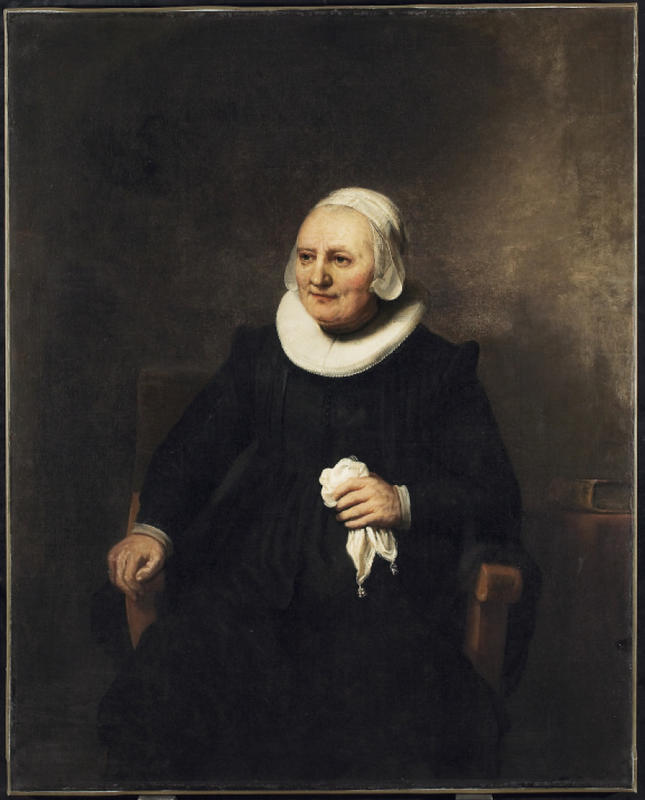More about Portrait of a Seated Woman with a Handkerchief

Contributor
Portrait of a Seated Woman With a Handkerchief is a classic Dutch oil painting by Carel Fabritius - but we didn’t always know that.
For years, scholars believed this painting to have been completed by popular Dutch master Rembrandt. And not unduly so: the painting *appeared* to have been signed by Rembrandt himself and was produced by Rembrandt’s own studio. However, after much investigation, it was revealed that (gasp!) the painting was a forgery. Or at least, the signature was. The rest of the painting was an original work likely produced by Carel Fabritius: Rembrandt’s student, friend, and guy best known for the painting on the cover of "The Goldfinch." If I doodled a tree and then signed it “Picasso,” art historians would have a fairly easy time figuring out it wasn’t legitimate. But, unlike my hypothetical Picasso doodle, Fabritius’ work is of a remarkable quality and achieves arguably the same caliber as a Rembrandt.
While a lot of Fabritius’ work ended up getting destroyed— more on that later— Portrait of a Seated Woman has stuck around through the centuries, making its way through galleries around the world and finally landing in the Art Gallery of Ontario. Most of Rembrandt’s students were content to copy the master and were reluctant to introduce their own spin on things— but not Fabritius. This ingenuity turned out to be tremendously helpful for art historians, who were able to attribute the painting to Fabritius by analyzing the many ways it differs from the majority of Rembrandt’s works, most notable in his treatment of the hands and face.
As stated earlier, Portrait of a Seated Woman is unfortunately one of few paintings by Fabritius we have today. In 1654, 90,000 pounds of gunpowder combusted in a massive explosion that shook the city of Delft, killing over a quarter of its inhabitants— including Fabritius. The blast also was responsible for the destruction of almost all his work, but Portrait of a Seated Woman survived, likely because it was housed in Rembrandt’s studio.
After that dramatic series of events, the painting had a fairly chill existence before being bought for 30,000 guineas— over a million dollars in today’s money— in the early 20th century. This sale marked the end of its “chill” phase as, a few short decades later, it was stolen from the Art Gallery of Ontario in an elaborate heist that involved five other paintings, including Portrait of Isaac Abrahamsz. Massa. At the time, Woman with a Handkerchief was still believed to be a Rembrandt, making it the highest value piece nabbed by the thieves. The insurance company eventually paid a ransom (yes, an actual, spy movie-style ransom) to get the painting back, which may not have happened if they had known the painting was not a genuine Rembrandt after all. A rare turn of good luck for poor Fabritius.
Sources
- Bruyn J., Haak B., Levie S.H., Van Thiel P.J.J., Van De Wetering E. (1989) Portrait of a seated woman with a handkerchief. In: A Corpus of Rembrandt Paintings. Stichting Foundation Rembrandt Research Project, vol 3. Springer, Dordrecht. https://doi.org/10.1007/978-94-009-0811-6_83
- McLeave, Hugh. Rogues in the Gallery: The Modern Plague of Art Thefts. Boston: David R. Godine, 1981.
- Rech, A., & Janson, J. (n.d.). Vermeer's Delft Today. http://www.essentialvermeer.com/delft/delft_today/delft_today_start.html.
- Portrait. Listory. (n.d.). https://www.listory.org/lists/paintings?id=Portrait_of_a_Seated_Woman_w….
Featured Content
Here is what Wikipedia says about Portrait of a Seated Woman with a Handkerchief
Portrait of a Seated Woman with a Handkerchief is a painting at the Art Gallery of Ontario, in Toronto. Today it is attributed to Carel Fabritius, but was previously considered a work by Rembrandt.
The work was sold in 1845 as part of the auction of the collection of Joseph Cardinal Fesch. It was later in the collection of Sir George Holford of Dorchester House, London. It was sold alongside the rest of the collection at Christie's in 1928. While still attributed to Rembrandt it was bought at auction by the Eaton's corporation for 30,000 Guineas. The company displayed the portrait at their College Park store and later at stores in Montreal and Winnipeg; at the time the only Rembrandt on public display in Canada. It was later moved to one of the private rooms of the College Street building and was then given as a retirement present to R.Y. Eaton. He loaned the painting to the Art Gallery of Toronto and his widow donated it in 1966. In 1959, it was one of six works stolen from the gallery. The thieves targeted the most valuable works, also taking the Portrait of Isaak Abrahamsz. Massa and Rembrandt's Young Woman with a Lapdog. Then still believed to be a Rembrandt, Woman with a Handkerchief had the highest value of those stolen according to the gallery's insurance.
The painting is signed "Rembrandt f. 1644" and this signature was long accepted as valid. It is today known that there are many works with Rembrandt signatures that were faked. Some of these are works produced in Rembrandt's workshop, often following an initial sketch of Rembrandt's. Others are pure forgeries with the signature added at a later date to increase its value. The painting does date from the era of Rembrandt, and the date could be accurate. It is rejected as the hand of Rembrandt as the hands and face of the portrait are painted in a distinctive style, and a style very different from Rembrandt's. The style is similar to the surviving works of Carel Fabritius, one of Rembrandt's most skilled pupils. There is still considerable scholarly debate over whether the painting is truly one by Fabritius.
There has also long been speculation over the identity of the sitter. Aaltje van Uylenburgh, a cousin of Rembrandt's wife Saskia, is the most common conjecture. The pose of the sitter suggests the painting was paired with a portrait of the woman's husband. A painting known as Portrait of a Scholar is of the same size and general style. It today hangs in Cologne and is believed to depict J.C. Sylvius, van Uylenburgh's husband. The two paintings are also recorded as having been sold together in a sale in 1811.
Check out the full Wikipedia article about Portrait of a Seated Woman with a Handkerchief












